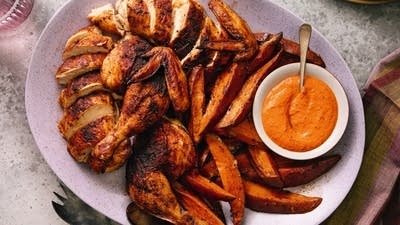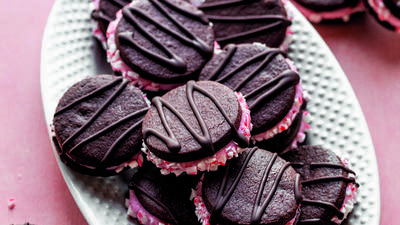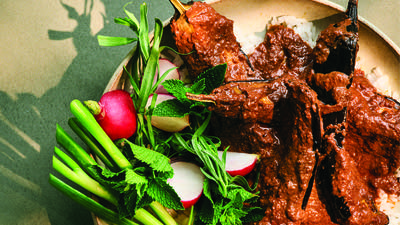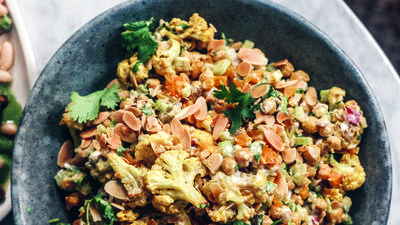
Buying Shrimp
It's preferable to buy shrimp frozen - most are sold in five-pound blocks - as fresh is rare and thawed shrimp gives neither the flavor of fresh nor the flexibility of frozen. The shelf life of thawed shrimp is only a couple of days, whereas shrimp stored in the freezer retain their quality for several weeks.
Avoid peeled and deveined shrimp; cleaning before freezing may cause a loss of flavor and texture.
Avoid brown shrimp, especially large ones, if your palate is sensitive to iodine as they are the most likely to taste of this naturally occurring mineral.
Size: Few rules govern the sale of shrimp and size classifications are subjective and relative. Learn to judge shrimp as retailers do - by the number of shrimp it takes to make a pound. Shrimp of from 15 or 20-30 per pound usually give the best combination of flavor, ease, and value.
Shrimp should have no black spots or melanosis on their shell, which indicates breakdown of the meat has begun. Likewise, avoid shrimp with yellowing shells or those that feel gritty as either may indicate the use of sodium bisulfite, a bleaching agent sometimes used to remove melanosis.
Shrimp should smell of saltwater only and, when thawed, should be firm and fill the shell fully.
Species: Of the 300 hundred species of shrimp worldwide, 6 are most commonly found in our markets:
Gulf White: Certainly the most expensive, and frequently the best. Good flavor, firm texture, usually grayish white in color. Similar in appearance to the less desirable Gulf brown shrimp, so select carefully – ask to see the box, which might be of help. Note: Mark feels these are the best, especially when fresh, but aren't easy to find.
Ecuadorian or Mexican White: Similar to Gulf whites, these may be wild (most Mexicans) or farm-raised (all Ecuadorian). More Ecuadorian shrimp is imported to the United States than any other.
Black Tiger: Widely farmed shrimp from Asia. May be dark gray with black stripes and red feelers or bluish with yellow feelers; pink when cooked. Can be quite flavorful and firm, but inconsistent.
Gulf Pink: High quality, wild or farm-raised. Shell is usually redder that that of whites, but may be light brown.
Gulf Brown: Wild shrimp most likely to taste of iodine, reddish brown, can be easily confused with whites or pinks.
Chinese White: Asian farm-raised with grayish white color, soft, sometimes watery texture, mild flavor. Usually relatively inexpensive. Benefits greatly from brining treatment.
Rock Shrimp: From the mid-Atlantic, southern states, and Gulf of Mexico. Good-tasting but very hard to peel, usually sold peeled and frequently cooked.
Cooking Shrimp
Defrost shrimp in the refrigerator or in cold water. Do not defrost in a warm place or microwave - moisture, nutrients, and weight will be lost.
Partial defrosting to cut a block in half for freezing for later use is, while not ideal, still preferable to buying thawed shrimp.
Cook a couple shrimp as soon as purchased to check for flavor, texture and presence of an iodine taste. Then store the remaining block in the freezer or return to the store if the test shrimp are mushy or taste of iodine.
Brining: Improves flavor and texture of most shrimp. Stir 1 cup salt and 1/2 cup sugar into 2 cups boiling water until dissolved; pour into large bowl filled with ice and water, and add up to 2 pounds shrimp. Let sit in the brine, refrigerated (or add ice occasionally) for 2 hours or so. Rinse the shrimp well.
Shrimp cook in as little as 3 minutes; when they're pink, they're done.
Peeling: Remove the shell before cooking if the shrimp will be served in hot liquid. Leave the shell on if poaching shrimp for later use, or if grilling as the shell protects the meat. The shell has good flavor which will be imparted to the shrimp if left on during cooking.
Deveining: Mark says he never bothers to devein shrimp unless butterflying it, in which case it's unavoidable. But there's no harm in deveining if you prefer to do so.
Before you go...
Each week, The Splendid Table brings you stories that expand your world view, inspire you to try something new, and show how food connects us all. We rely on your generous support. For as little as $5 a month, you can have a lasting impact on The Splendid Table. And, when you donate, you’ll join a community of like-minded individuals who love good food, good conversation, and kitchen companionship. Show your love for The Splendid Table with a gift today.
Thank you for your support.
Donate today for as little as $5.00 a month. Your gift only takes a few minutes and has a lasting impact on The Splendid Table and you'll be welcomed into The Splendid Table Co-op.



